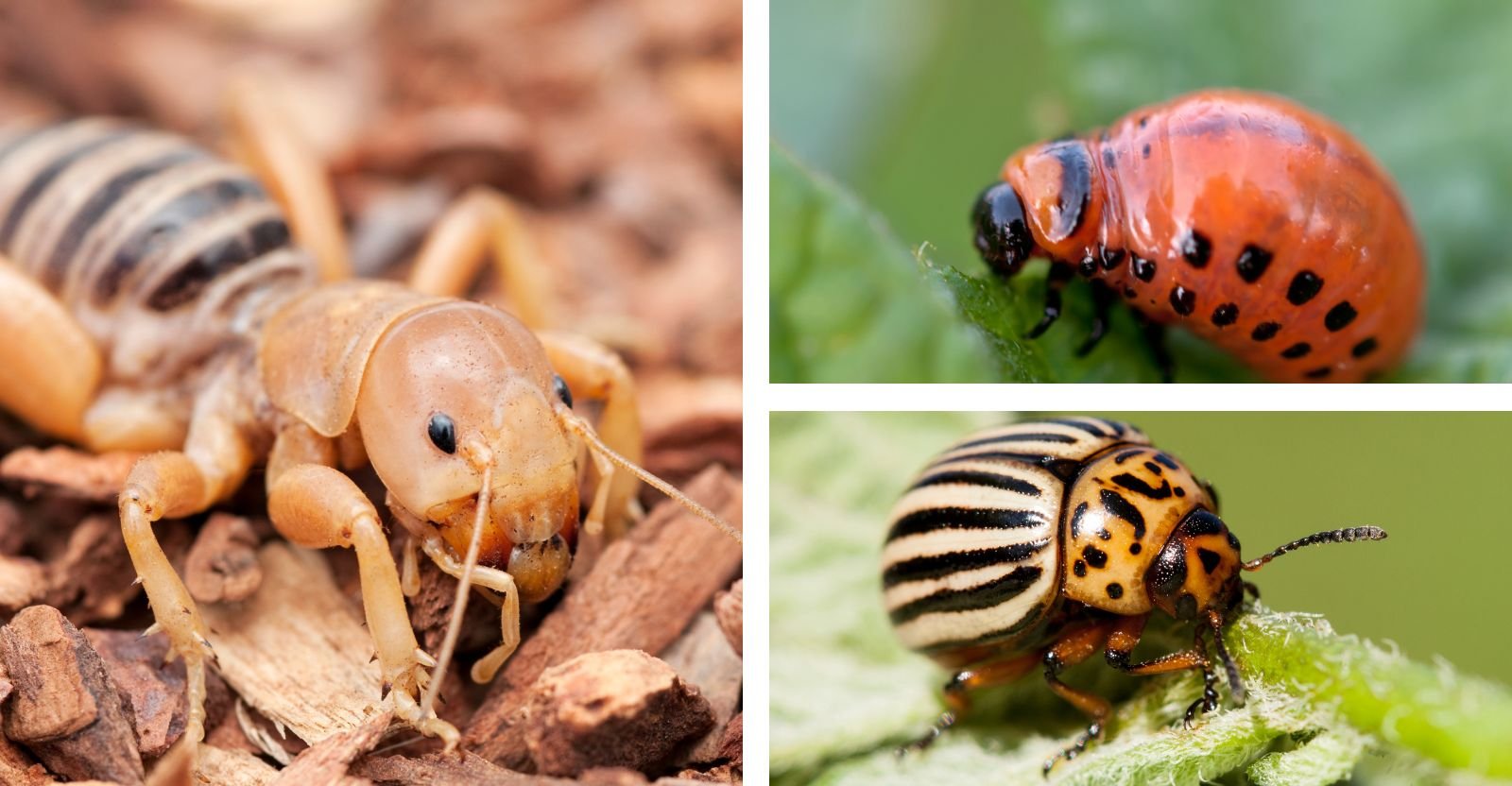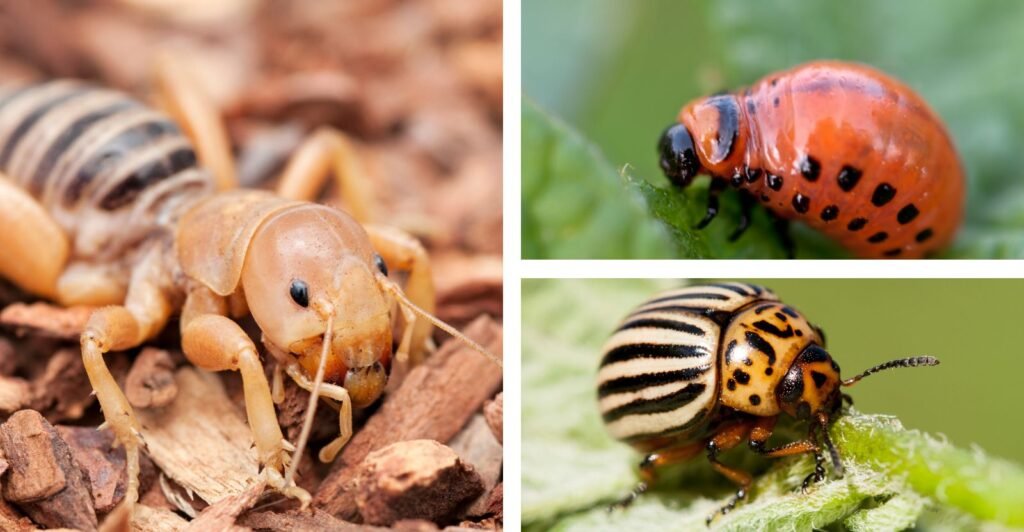
How to Identify and Control Potato Bugs
If you’re a gardener, you’ve likely encountered potato bugs, or you will soon. These pests can be a real headache, especially when you’re trying to grow healthy potatoes and other root vegetables. Potato bugs, or potato beetles, are a common pest problem that many gardeners face. They’re nocturnal, hiding during the day and coming out at night to feast on your crops.
These bugs can be tricky to identify at first, and it might not always be obvious how to get rid of them. But don’t worry, we’ve got you covered with everything you need to know about potato bugs and how to deal with them in your garden.
What is a Potato Bug?
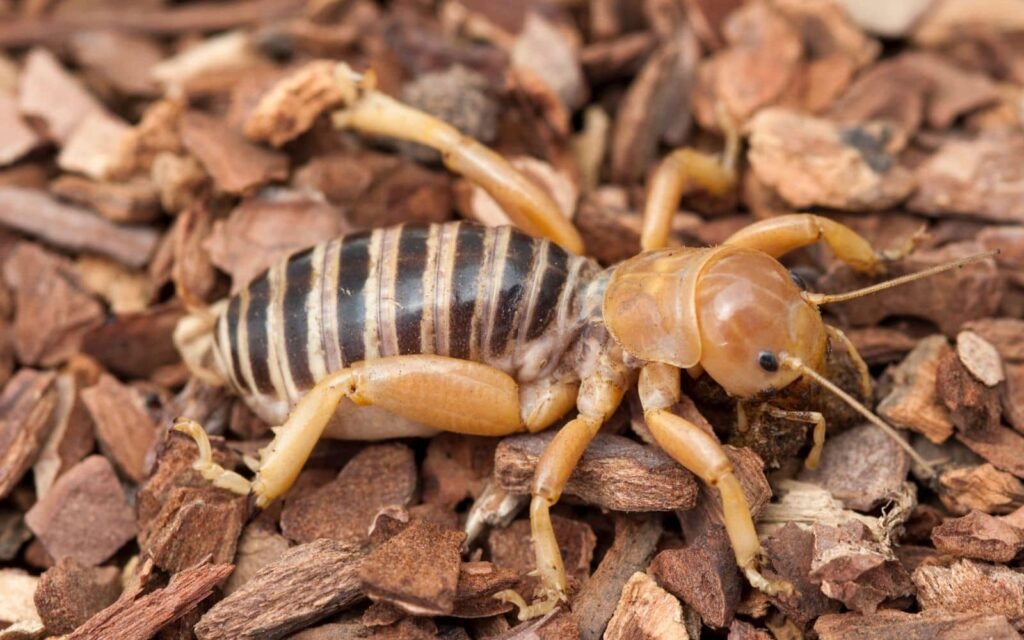
The term “potato bug” can refer to different insects, most notably:
- Colorado Potato Beetle (Leptinotarsa decemlineata)
- Jerusalem Cricket (Stenopelmatus fuscus)
These pests belong to the same insect family as grasshoppers, katydids, and crickets. While their diet mainly consists of roots, vegetables, fruits, and sometimes smaller insects, they are not poisonous. However, they can bite if threatened, so it’s important to handle them carefully.
The Colorado potato beetle is particularly notorious for attacking potatoes, and its larvae can quickly cause significant damage. Jerusalem crickets, though larger, are less damaging to potato plants but still contribute to the pest problem.
What Do Potato Bugs Look Like?

- Colorado Potato Beetle: These beetles have a distinctive appearance with dark black stripes running across their yellow-orange bodies. Adults are about 1/3 inch long, and their larvae start as tiny, rust-colored grubs but develop into orange, humpbacked larvae with black spots along their sides. They also lay yellow eggs in clusters on the undersides of leaves.
- Jerusalem Cricket: These large insects are reddish-brown with long, powerful legs and an amber-yellow head. They resemble crickets but are larger, growing up to 2-3 inches long. Jerusalem crickets don’t have wings, and their large jaws and alien-like appearance give them a unique, slightly intimidating look. They also tend to live in moist, dark environments and are rarely seen indoors unless the weather outside is extreme.
Life Cycle of Potato Bugs

Colorado Potato Beetle:
- Overwinters in the soil and emerges in the spring to search for host plants.
- Adult females lay 500-600 eggs in clusters, which hatch within 5-10 days.
- The larvae feed on potato leaves and then pupate in the soil before emerging as adults.
- There can be 2-3 generations of these beetles each year.
Jerusalem Cricket:

- These insects are nocturnal and prefer cooler, moist environments.
- Female Jerusalem crickets can lay up to 500 eggs, which hatch into nymphs in 1-2 weeks.
- They feed on plant roots and decomposing matter, though they’re not as destructive to potatoes as the Colorado potato beetles.
What Damage Do Potato Bugs Cause?
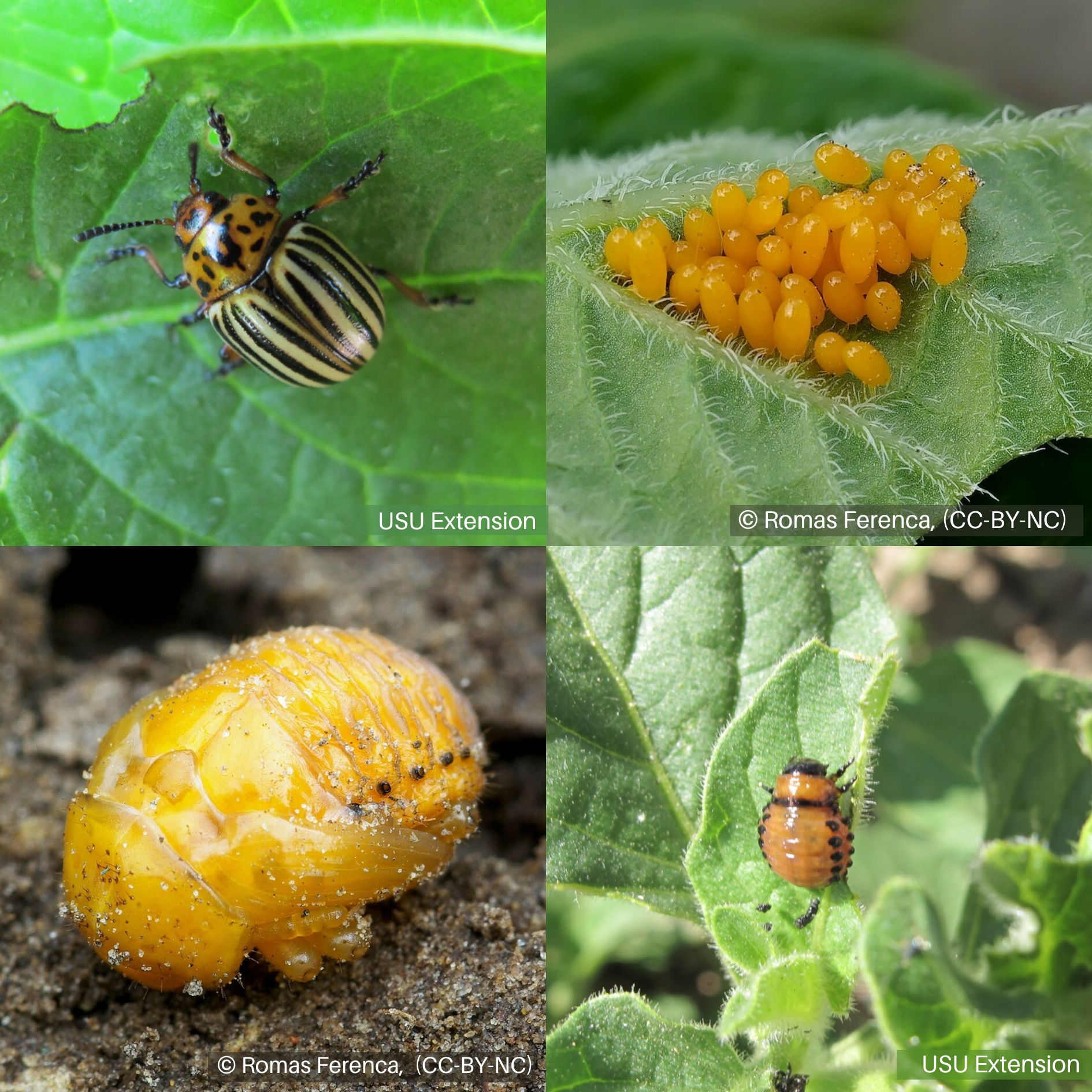
Both the adult potato bugs and their larvae feast on the leaves, stems, and roots of potato plants. As they feed, they release a toxic saliva that can stunt the plant’s growth and reduce crop production. In severe cases, this can cause the plant to wither and die.
- Colorado Potato Beetle: They can damage both young and mature plants, leaving behind skeletonized leaves. These beetles often move from one plant to another after causing significant damage.
- Jerusalem Cricket: While they feed on roots, they are generally less harmful to plants. However, they still can disrupt plant health by consuming smaller roots.
How to Get Rid of Potato Bugs in Your Garden

Dealing with potato bugs doesn’t have to be overwhelming. Here are some effective methods to manage and control these pests in your garden.
1. Scouting and Manual Removal
Start checking your plants in early May, when the beetles first emerge. Look under the leaves for the characteristic yellow eggs. For small infestations, manual removal is often the most effective way to get rid of them.
- How to remove:
- Wear gloves and use a small stick or hand tool to remove the beetles and larvae.
- Drop them into a container with soapy water to kill them.
- For a more thorough job, you can use a residential vacuum cleaner to suck them up (but avoid using it on loose soil).
- A petroleum jelly trap can also help by catching beetles as they crawl through it.
2. Crop Rotation
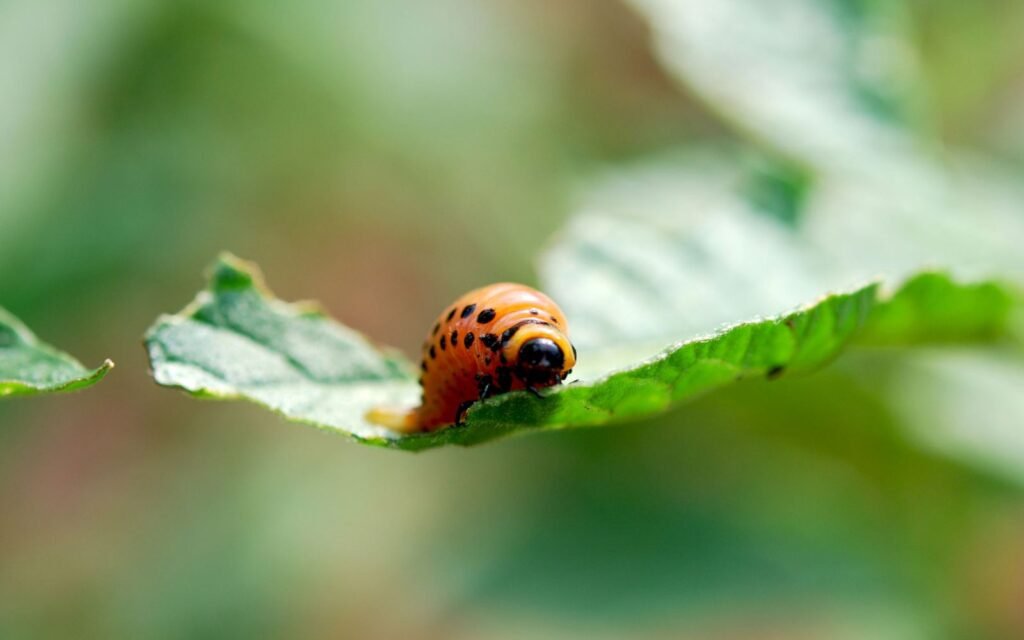
Rotate your crops every year to prevent the build-up of pests like potato bugs. Planting potatoes in a different spot each year disrupts the beetle’s life cycle, preventing them from finding their preferred food source.
- Tip: You can plant trap crops like a few potato plants to lure beetles away from your main crops. Once the beetles are concentrated on those plants, remove them by hand or with a torch.
3. Use Potato Bug-Resistant Plants

Companion planting can help deter potato bugs. Consider planting horseradish, marigolds, catnip, cilantro, or bush beans near your potatoes. These plants naturally repel pests and can help keep your crops safe.
4. Use Mulch
Applying mulch, such as wheat straw, around your potato plants can provide several benefits. It helps retain moisture, keeps the soil temperature steady, and also attracts beetle predators like birds and other insects. In winter, you can remove the mulch to expose the beetles to cold weather, which helps kill them naturally.
5. Create a Trench Around Your Potatoes

Create a trench around your potato field to prevent beetles from reaching your plants. The trench should be at least 12 inches deep with steep sides. You can also use plastic sheets to make it even harder for beetles to climb into your garden.
Natural Predators of Potato Bugs

Encouraging natural predators in your garden is an excellent way to control potato bugs. Predators like ladybugs, lacewings, chickens, ducks, and birds are all effective at keeping the potato beetle population in check.
- Mini-Wasp Edovum puttleri: This mini-wasp is particularly effective against potato beetle eggs. You can buy them commercially and release them in your garden to keep the beetles under control.
- Nematodes: These microscopic worms can be introduced to the soil to target and kill potato bug larvae buried in the ground.
Other Control Methods
- Diatomaceous Earth: This non-toxic powder made from fossilized algae can be sprinkled around your plants. It has microscopic sharp edges that cut into the beetles’ bodies, dehydrating and killing them.
- Neem Oil: Neem oil works by disrupting the beetles’ exoskeletons and preventing them from feeding. It’s a natural and safe option for controlling potato bugs in your garden.
How to Treat Potato Bug Bites
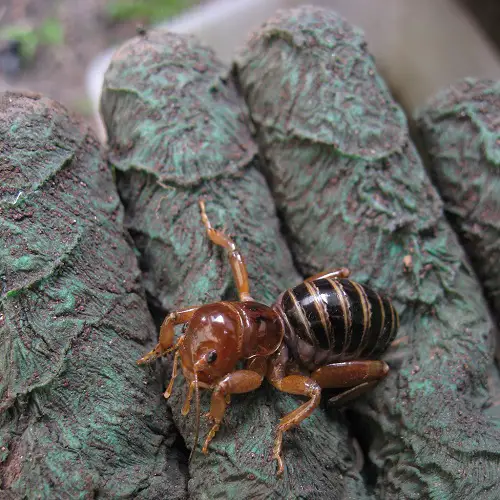
While rare, if you happen to get bitten by a potato bug like a Jerusalem cricket, the bite can be painful. It’s not toxic, but it might cause redness and swelling. Wash the affected area with clean water and apply a moisturizing cream to soothe the bite.
By using these methods and staying proactive, you can keep potato bugs at bay and ensure your potato plants remain healthy and productive. Happy gardening!
FAQs for Dealing with Potato Bugs
1. What are potato bugs, and how can I identify them?
Potato bugs, also known as Colorado potato beetles, are common pests that attack potato plants. The adult beetles are yellow with black stripes on their bodies, and they lay orange or red eggs on the undersides of leaves. The larvae are reddish with black spots, and they feed on the leaves, which can result in severe damage to the plant.
2. Why are potato bugs harmful to potato plants?
Potato bugs damage potato plants by feeding on the leaves and stems. This can weaken the plant, reduce photosynthesis, and stunt growth. Heavy infestations can lead to defoliation, and if left unchecked, potato bugs can severely reduce your potato yield.
3. How can I prevent potato bugs from attacking my potato plants?
To prevent potato bugs, consider these methods:
- Crop rotation: Avoid planting potatoes or other nightshades (tomatoes, peppers, etc.) in the same spot every year, as potato bugs tend to return to the same location.
- Mulching: Apply a layer of mulch around your potato plants to make it harder for the bugs to reach the plants.
- Floating row covers: Use lightweight, breathable row covers to physically block the beetles from reaching your plants while still allowing air and water to circulate.
- Maintain plant health: Healthy plants are less susceptible to pest damage, so ensure your potatoes are properly watered and fertilized.
4. How can I control potato bugs naturally?
There are several natural methods to control potato bugs:
- Handpicking: Regularly inspect your plants for adult beetles and larvae. If you find any, remove them by hand and drop them into a bucket of soapy water.
- Neem oil: Neem oil is an organic insecticide that can help control potato bugs without harming beneficial insects.
- Diatomaceous earth: Sprinkle food-grade diatomaceous earth around your potato plants. It acts as a mechanical barrier that dehydrates and kills the bugs.
- Beneficial insects: Introduce natural predators like ladybugs or lacewings, which will eat potato bug larvae.
5. Can I use chemical pesticides to control potato bugs?
Chemical pesticides can be effective, but they should be used cautiously, as they can harm beneficial insects and disrupt the ecosystem. If you choose to use pesticides, opt for ones specifically designed for potato bugs and follow the manufacturer’s instructions carefully. It’s also best to apply them in the early morning or evening to minimize harm to pollinators.
6. What should I do if I have a severe infestation of potato bugs?
For severe infestations, you may need to use stronger interventions. Consider applying organic insecticides like pyrethrin or insecticidal soap. If the infestation is widespread, you may need to remove heavily damaged plants to prevent the bugs from spreading further. Regularly inspect and treat your plants to control the population.
7. How can I keep potato bugs away from my garden entirely?
To keep potato bugs out of your garden:
- Use companion plants: Some plants, such as marigolds and garlic, are known to repel potato bugs. Consider planting them alongside your potatoes.
- Regularly remove weeds: Weeds can harbor pests, so keep your garden area tidy and remove any unwanted plants.
- Trap crops: Consider planting trap crops like horseradish near your potatoes. The beetles are attracted to these plants, which can help protect your main crop.
8. When is the best time to inspect my potato plants for bugs?
The best time to inspect your potato plants for bugs is in the early morning or late evening when the beetles are most active. Check both the tops and bottoms of the leaves for eggs, larvae, and adult beetles. Regularly inspecting your plants helps catch infestations early, preventing significant damage.
9. Can I use potato bugs to benefit my garden?
While potato bugs are typically harmful to your plants, their larvae can be fed to chickens or other poultry. They can be used as an organic source of protein for your farm animals. However, this is only viable if you are able to control the beetle population, as large numbers of them can severely damage your crops.
10. Will potato bugs attack other plants in my garden?
Potato bugs are primarily attracted to plants in the Solanaceae family, which includes potatoes, tomatoes, eggplants, and peppers. While they generally prefer these plants, they may also target other nightshade plants in the same family. Keep an eye on other crops in your garden and take action if you notice signs of infestation.
11. How long does it take for potato bugs to cause significant damage?
Potato bugs can cause significant damage fairly quickly, especially during peak breeding seasons (spring and early summer). If left unchecked, a large infestation can defoliate a plant within a few weeks, significantly impacting the yield. Early detection and prompt action are key to preventing severe damage.
12. How do I know when to harvest my potatoes if I have a potato bug infestation?
If you’ve been dealing with a potato bug infestation, you’ll want to harvest your potatoes once the plants begin to die back or show signs of severe damage. This indicates that the potatoes are ready for harvest. To prevent further damage, harvest before the bugs have a chance to damage the tubers beneath the soil.
Conclusion
Dealing with potato bugs requires vigilance and proactive measures to ensure healthy, productive potato plants. By using natural deterrents, maintaining proper garden hygiene, and acting quickly when infestations occur, you can keep these pests at bay and protect your crop. With consistent care and attention, you’ll enjoy a bountiful harvest. Happy gardening! 🌱🥔

